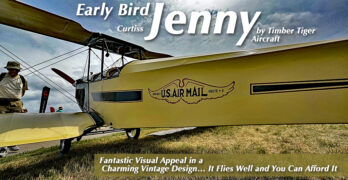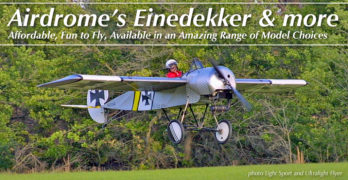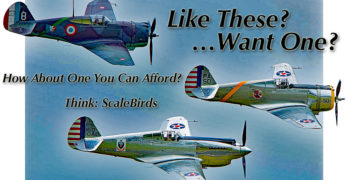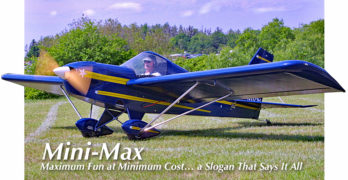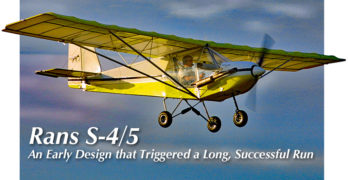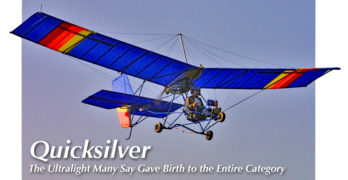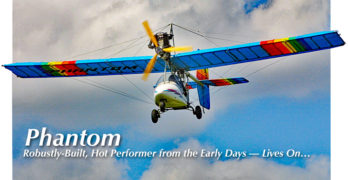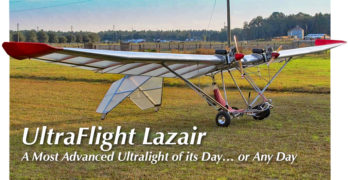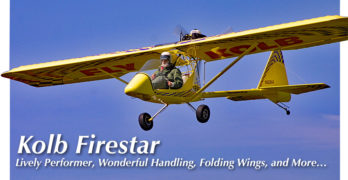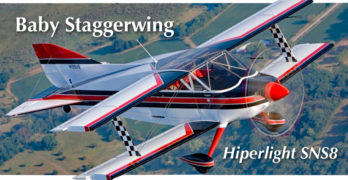Think about this. If you land your Timber Tiger Jenny at any GA airport and taxi up to the ramp, you might have trouble getting out of the cockpit for all the admirers that will assemble around you.
Take a close look at this example built by John Youngblut. You are quickly charmed by fond images of an earlier period in aviation. Then you look deeper, noticing its shaped wood struts, leather trim, and classic analog guages. This draws you in further and I watched people get closer and closer as they examined the detail.
All that leaves out how well it flies, which developer Nick Pfannenstiel reported was the #1 appeal of the airplane. So after enjoying an easy, relaxing flight in your Jenny, you land to be swarmed by people who believe they’ve just witnessed a piece of history fly into their lives.
Jenny began life as a Curtiss, was recreated in scaled down form by Early Bird Aircraft (Gen 1) and kits are now manufactured by Timber Tiger Aircraft, which has reimagined again in slightly larger scale, better fitting modern Americans.
Search Results for : vintage
Not finding exactly what you expected? Try our advanced search option.
Select a manufacturer to go straight to all our content about that manufacturer.
Select an aircraft model to go straight to all our content about that model.
Affordable Aircraft Kits with Genuine Vintage Appeal; that’s Airdrome Aeroplanes
Recently I wrote about an American classic, Luscombe’s Model 8 LSA. We can go back even further in time and uncover a handsome flock of highly affordable airplanes that also check the vintage box.
Welcome to Robert Baslee‘s amazing production of vintage early 20th Century airplanes that ordinary people can build and fly.
Airdrome’s many models — five of which can be built as Part 103 ultralights — look like a page from history but fly well in the modern world.
Here is one man’s very successful mission to both preserve aviation heritage and give you the chance to participate in the fun …without having to do all the research Robert does. As a bonus, many of these kits assemble much faster than many kit designs.
Modern Pilots,
Meet Airdrome Aeroplanes
Robert is incredibly productive. In the video below, he notes he has introduced 25 new models in 25 years.
Vintage Light Kit Aircraft Heaven — Checking out ScaleBirds’ Curtis P-36 with 5-Cylinder Engine
ScaleBirds is not your run-of-the-mill kit aircraft company. In truth, all kit builders are amazing to me.
People who labor for years to design an aircraft, craft methods for making the constituent parts, assemble it all, work out bugs in construction, fly the aircraft, then smooth any rough edges of its flight qualities, start producing kit components — and the manual it will take for a non-expert to build the kit (perhaps the hardest task) — and finally, start the effort of telling people about the airplane, market it, sell it — and the big one — try to turn a profit for doing all the preceding. Any way you cut it, birthing a new design is an immense project.
Sam Watrous, his son Scott, and their merry band of (mostly volunteer) ScaleBirders are not merely doing all the above. They are emulating vintage American military designs in reduced scale and trying to get the details right so the kit versions look as much as possible like the originals.
Ultralight April 2020 — Tenth in the Vintage Series: Team Mini-Max
The grand finale to this series on Vintage Ultralights during the month of April 2020 focuses on an airplane that can be very inexpensive if bought used. However, even new models are quite the bargain brand new — $6,195 for a complete Mini-Max kit, not including engine, instruments, or paint — from Team Mini-Max LLC. The big difference is you must build a new one. For some this may be pure delight. Others want to fly sooner or don’t care to tackle the building effort.
As alert readers may have noticed, Mini-Max shares something with the third in this series, Fisher’s Koala. That also-mostly-wood aircraft was designed by Mike Fisher and Wayne Ison. The last man was the principal of Team Aircraft in Tennessee. Ison passed away in August of 2014 at the age of 90.
Wayne had a gentle yet determined way about him that I recall well.
Ultralight April 2020 — Ninth in the Vintage Series: Rans S-4/5
This first year I ever saw Randy Schlitter fly one his models at an airshow seems a hundred years ago. Indeed, since that distant memory at Sun ‘n Fun, this Kansas company has created a profusion of designs and delivered nearly 5,000 aircraft. To say it has been a great run qualifies as a significant understatement.
Today’s S-21 Outbound (pilot report video) or S-20 Raven (pilot report video) seem a long ways off from those very early models yet it does not take an expert eye to see they are clear descendants from the original Rans aircraft.
What began this fascinating evolution of a light airplane company started almost 40 years ago — here’s a report on the very first model, still flying! That humble little Coyote (Kansas is a U.S. prairie state so coyotes are a logical name) began something great but it remains a wonderful light airplane that you can buy today for a song.
Ultralight April 2020 — Eighth in the Vintage Series: Quicksilver MX
Ah, the Quicksilver! Where to start with this veritable icon of the ultralight sector?
With more than 15,000 flying, it even outranks Van’s Aircraft for kit aircraft that made it into the air — although Van’s has sold more kits in total and no one disputes the Western brand’s leadership position.
The earliest Quicksilvers were hang gliders (last photo). Engines came later but at first the weight-shift seat stayed (nearby image). The pilot had lateral control — still by weight shift — but via lines that moved surfaces. Pitch, however, was fully controlled by the pilot moving his or her body.
Those were fun days and provided wonderful memories (yes, I flew them as weight-shift aircraft). Yet the brand went on to vastly greater development. In this article, our focus is on the original three-axis control model, the oh-so-famous MX (multiple axis).
Quicksilver MX
Quicksilver’s MX entered the market in the early 1980s, like all the models featured in our Vintage Ultralight series.
Ultralight April 2020 — Seventh in the Vintage Series: Ultralight Flight Phantom
When the Phantom was introduced to the ultralight market at Sun ‘n Fun in 1982, it won the Best New Design award, not only for good looks and strong performance but for its structural integrity! Indeed, it was touted as having been tested to +9 and –6.6 Gs. Though dismissed by some pilots, wire-braced designs are actually very tough.
Phantom is a kit built from anodized aluminum tubing, bolted and riveted together. The wings, tail surfaces and ailerons are covered in Dacron sail cloth envelopes and Phantom used a double surfaced wing for better cross wind control and handling.
A wire-braced, high-wing, tricycle-gear ultralight aircraft in a tractor configuration, Phantom has a pilot pod with windscreen and a steerable nosewheel. (These were not common in those early days of ultralight vehicles.) Controls are standard stick and rudder — a left hand throttle and right hand joystick — with full span ailerons.
Ultralight April 2020 — Sixth in the Vintage Series: UltraFlight Lazair
The first time I ever saw Lazair fly — a fly-in at the Tullahoma Airport, as I recall — a then-young Peter Corley flew the lightweight aircraft as though he was the pilot of a military fighter of the day. He pushed the sleek machine with the whining engines as he looped and rolled the machine with such apparent ease. At this early time of development for these aircraft, such maneuvers in what we called an ultralight were very unusual.
To say either Peter or Lazair was unusual proved something of an understatement. Lazair was, and remains, one of the most unorthodox aircraft of any kind. Several reasons stand out to define its uniqueness.
These differences included: an inverted-V tail, said to be the most efficient tail planform; twin engines (the tiniest ones imaginable); an aluminum structure not based solely on round tubing; and see-through wing and tail coverings. All that is just the overview.
Ultralight April 2020 — Fifth in the Vintage Series: Kolb Firestar
Amazingly enough, here in 2020, we have noticeably returned to our roots in very light aircraft. Almost 40 years after Mike Sacrey and his team at FAA created the still-incredible Part 103, one leading brand from those days is not only still in business and thriving, but they are largely building similar aircraft to four decades back.
The man you saw on the lead photo is the famed Dick Rahill, a one-man flying machine flying his machine at Sun ‘n Fun more capably than any robot. Over and over, Dick would blast off in the bright yellow Firestar that seemed attached to him. He’d make one quick pattern from the turf runway in Paradise City at Sun ‘n Fun only to land, jump right back in the takeoff line, and repeat. Launch, circle, land, repeat… over and over. It seemed like every other airplane taking off was Dick and his FireStar.
Ultralight April 2020 — Fourth in the Vintage Series: Hiperlight SNS 8 Biplane
As we continue with this fourth in a series of ten about very affordable light aircraft from earlier times, we stress again that all the aircraft presented in this series still have some essential qualities that warranted their inclusion.
First, these are all aircraft with which Videoman Dave and I are personally familiar. I have flown all but one on the list and I believe Dave has flown all of them. So, we come to the series with real experiences in these flying machines. It has been a while for many of them, but assuming maintenance is good (see the important message at the end), this can be reasonable for many pilots to consider. However, as with any used aircraft, the buyer must be aware. Neither Dave nor I can comment on any one particular aircraft.
Second, and with the maintenance message firmly planted in your mind, all the models in this Vintage Ultralight series still have parts available from current-day producers.
- 1
- 2
- 3
- …
- 12
- Next Page »


